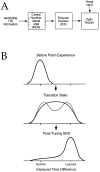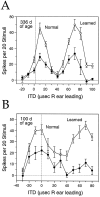Pharmacological specialization of learned auditory responses in the inferior colliculus of the barn owl
- PMID: 9526024
- PMCID: PMC6792594
- DOI: 10.1523/JNEUROSCI.18-08-03073.1998
Pharmacological specialization of learned auditory responses in the inferior colliculus of the barn owl
Abstract
Neural tuning for interaural time difference (ITD) in the optic tectum of the owl is calibrated by experience-dependent plasticity occurring in the external nucleus of the inferior colliculus (ICX). When juvenile owls are subjected to a sustained lateral displacement of the visual field by wearing prismatic spectacles, the ITD tuning of ICX neurons becomes systematically altered; ICX neurons acquire novel auditory responses, termed "learned responses," to ITD values outside their normal, pre-existing tuning range. In this study, we compared the glutamatergic pharmacology of learned responses with that of normal responses expressed by the same ICX neurons. Measurements were made in the ICX using iontophoretic application of glutamate receptor antagonists. We found that in early stages of ITD tuning adjustment, soon after learned responses had been induced by experience-dependent processes, the NMDA receptor antagonist D, L-2-amino-5-phosphonopentanoic acid (AP-5) preferentially blocked the expression of learned responses of many ICX neurons compared with that of normal responses of the same neurons. In contrast, the non-NMDA receptor antagonist 6-cyano-7-nitroquinoxaline-2,3-dione (CNQX) blocked learned and normal responses equally. After long periods of prism experience, preferential blockade of learned responses by AP-5 was no longer observed. These results indicate that NMDA receptors play a preferential role in the expression of learned responses soon after these responses have been induced by experience-dependent processes, whereas later in development or with additional prism experience (we cannot distinguish which), the differential NMDA receptor-mediated component of these responses disappears. This pharmacological progression resembles the changes that occur during maturation of glutamatergic synaptic currents during early development.
Figures











References
-
- Aizenman E, Lipton SA, Loring RH. Selective modulation of NMDA responses by reduction and oxidation. Neuron. 1989;2:1257–1263. - PubMed
-
- Bear MF, Cooper LN, Ebner FF. A physiological basis for a theory of synapse modification. Science. 1987;237:42–48. - PubMed
-
- Ben-Ari Y, Khazipov R, Leinekugel X, Caillard O, Gaiarsa J-L. GABAA, NMDA, and AMPA receptors: a developmentally regulated “menage a trois.”. Trends Neurosci. 1997;20:523–529. - PubMed
-
- Brainard MS, Knudsen EI. Dynamics of visually guided auditory plasticity in the optic tectum of the barn owl. J Neurophysiol. 1995;73:595–613. - PubMed
Publication types
MeSH terms
Substances
Grants and funding
LinkOut - more resources
Full Text Sources
